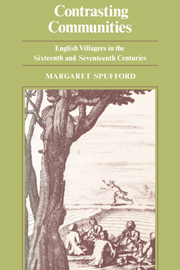Book contents
- Frontmatter
- Contents
- List of maps and graphs
- List of tables
- List of abbreviations
- Acknowledgements
- Dedication
- Introduction
- Map 1 Cambridgeshire: natural boundaries and soil types
- Map 2 Cambridgeshire: county and parish boundaries
- PART 1 People, Families and Land
- 1 The peopling of a county
- 2 The problem: the disappearance of the small landowner
- 3 The reality: the small landholder on the chalk: Chippenham
- 4 The reality: the small landholder on the clay: Orwell
- 5 The reality: the small landholder in the fens: Willingham
- General Conclusions to Part One
- PART 2 The Schooling of the Peasantry
- PART 3 Parishioners and their Religion
- Conclusion
- Appendix 1 The Butlers of Orwell
- Appendix 2 Notes on Graphs 3 and 5
- Index of Contemporary Names
- General Index
4 - The reality: the small landholder on the clay: Orwell
Published online by Cambridge University Press: 25 January 2010
- Frontmatter
- Contents
- List of maps and graphs
- List of tables
- List of abbreviations
- Acknowledgements
- Dedication
- Introduction
- Map 1 Cambridgeshire: natural boundaries and soil types
- Map 2 Cambridgeshire: county and parish boundaries
- PART 1 People, Families and Land
- 1 The peopling of a county
- 2 The problem: the disappearance of the small landowner
- 3 The reality: the small landholder on the chalk: Chippenham
- 4 The reality: the small landholder on the clay: Orwell
- 5 The reality: the small landholder in the fens: Willingham
- General Conclusions to Part One
- PART 2 The Schooling of the Peasantry
- PART 3 Parishioners and their Religion
- Conclusion
- Appendix 1 The Butlers of Orwell
- Appendix 2 Notes on Graphs 3 and 5
- Index of Contemporary Names
- General Index
Summary
Sources, fields, crops and stock
Orwell lies to the south-west of Cambridge. The parish now includes the territory of the lost village of Malton, which was ecclesiastically separate in the middle ages, and remained a separate manor outside the scope of this survey. Both geographically and socially, Orwell is strongly contrasted with Chippenham. The parish boundaries are formed on the south by the river Rhee, the western branch of the Cam, and on the north by the Mare Way, a prehistoric route which runs along the top of a steep ridge of boulder clay which projects here from the main boulder clay plateau to the west of the county. The village itself lies tucked away just under this ridge, off the main Roman road linking Cambridge with the Ermine Street, on the spring line and on the chalk which underlies it and which formed its building material. The chalk outcrop is relatively narrow here, however, and the soil south of the village down to the river alluvium is heavy and ill-drained, over gault clay. On the whole, therefore, the village is more geographically akin to those on the clay uplands than to those on the edge of the fens.
It is Orwell's situation which makes it worth investigation. The population history of the clay villages was very different from those on the fen-edge, and many, though not all, of them shrank during the sixteenth and seventeenth centuries. An examination of land distribution in one of them therefore seems particularly important.
- Type
- Chapter
- Information
- Contrasting CommunitiesEnglish Villages in the Sixteenth and Seventeenth Centuries, pp. 94 - 120Publisher: Cambridge University PressPrint publication year: 1974
- 1
- Cited by



